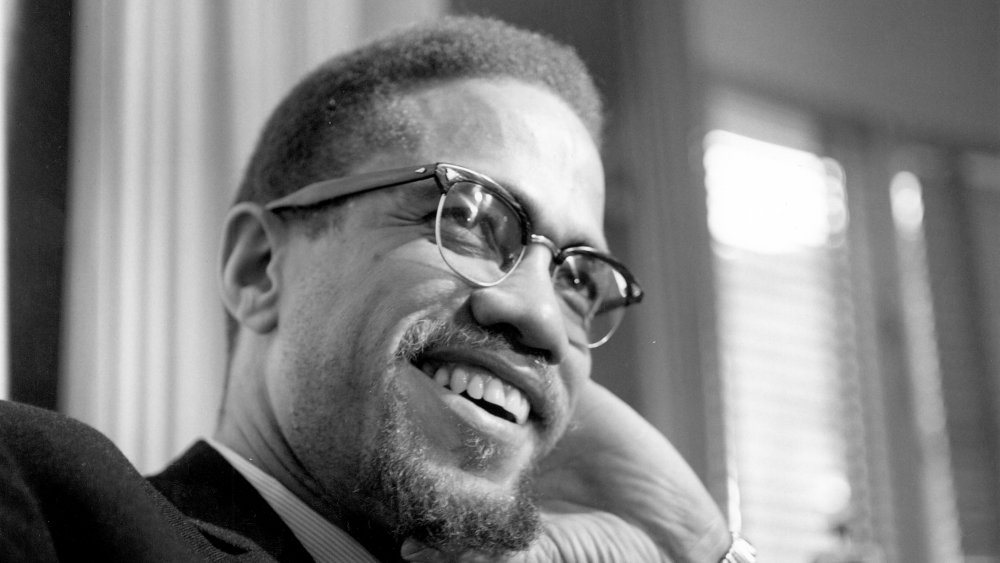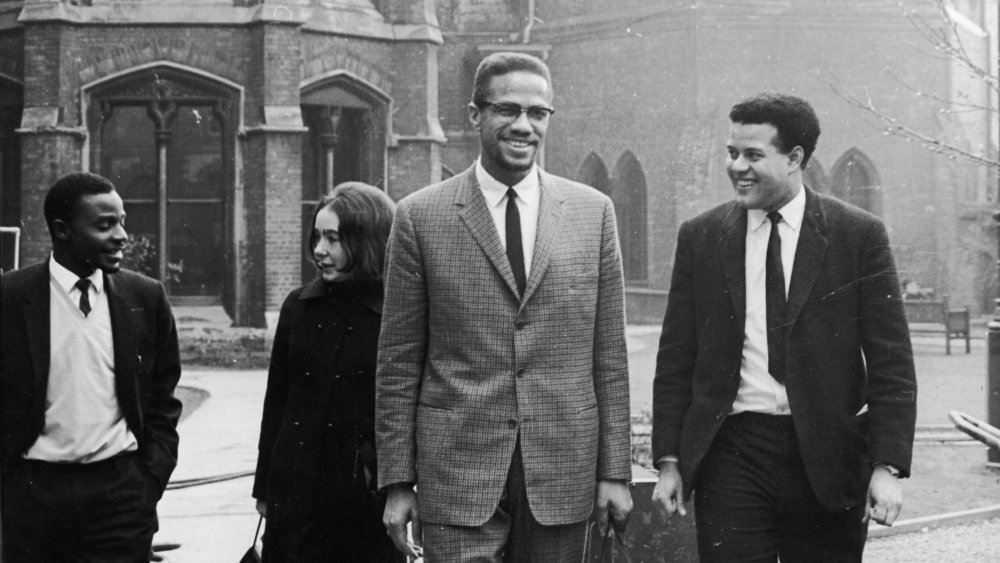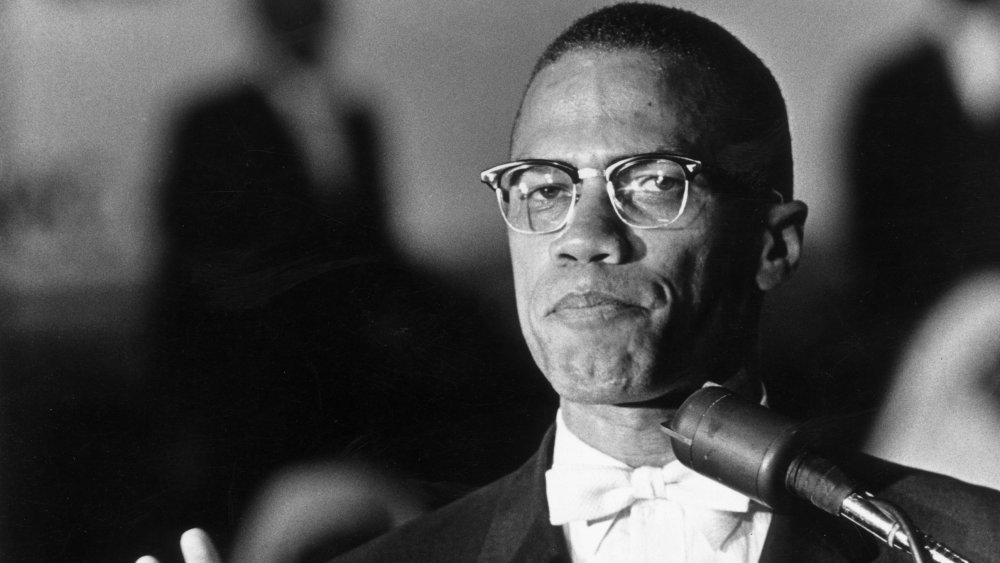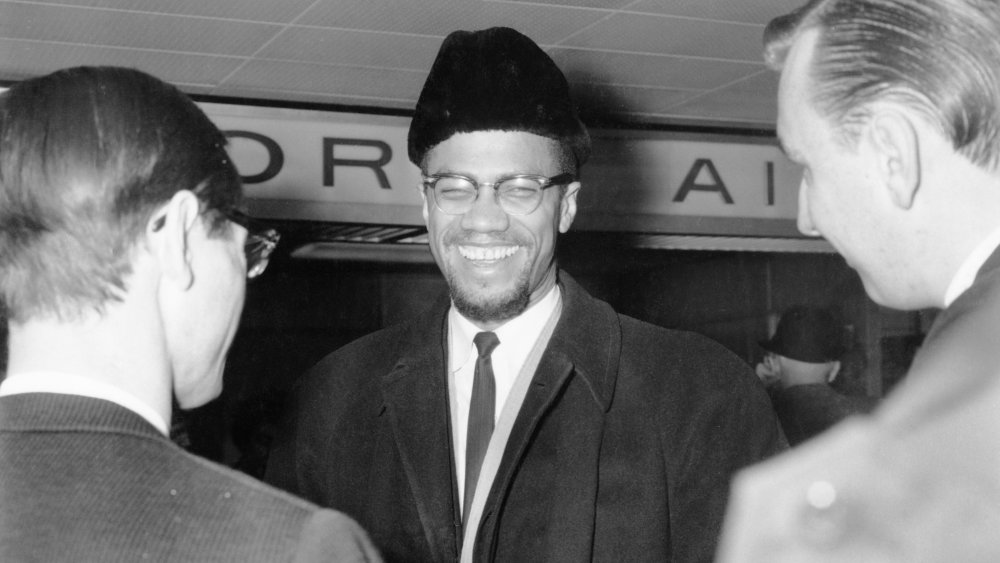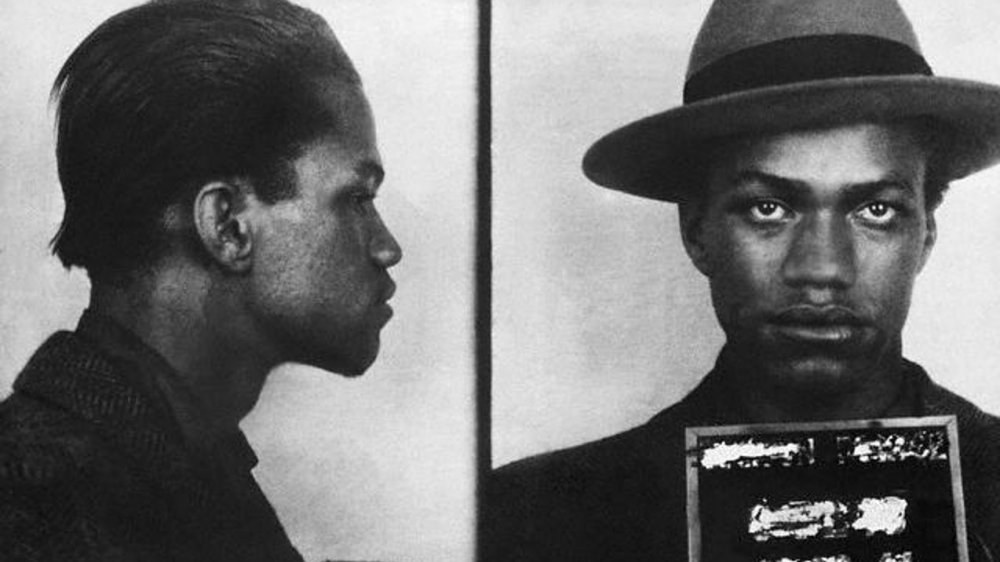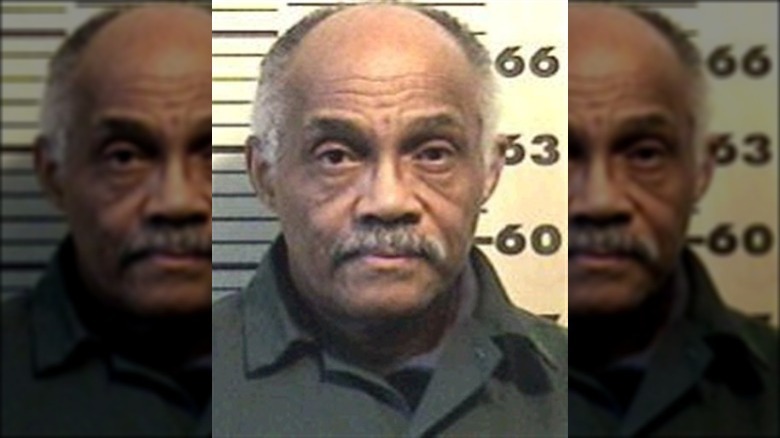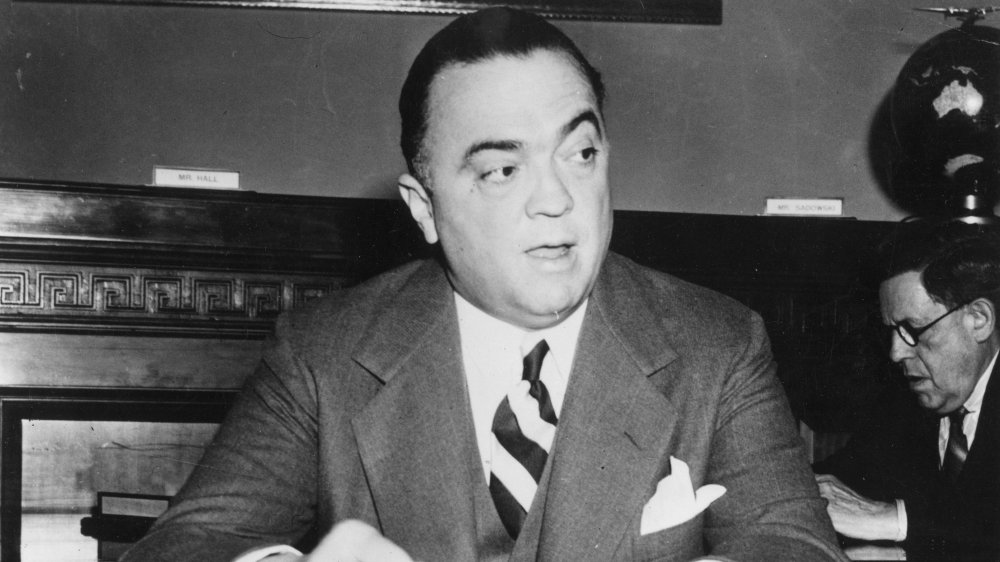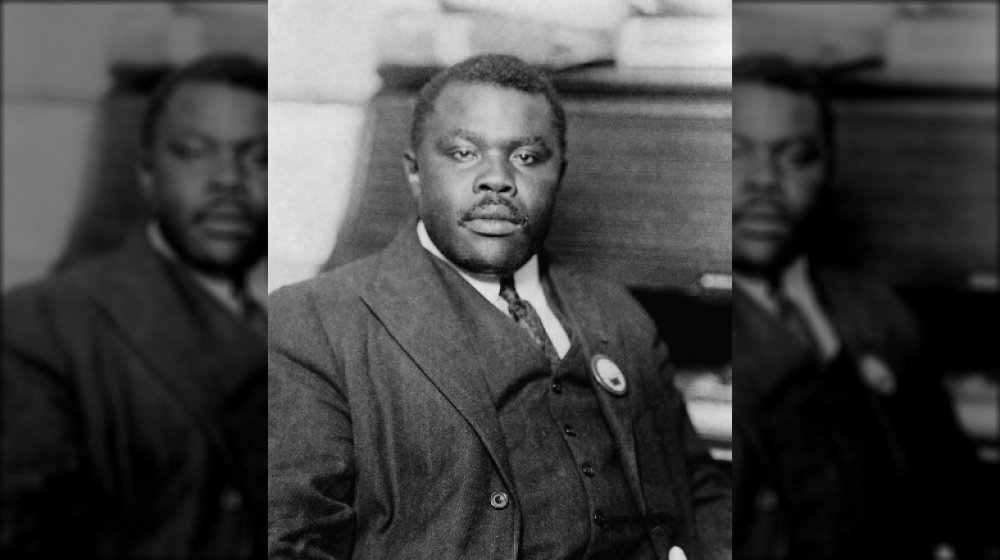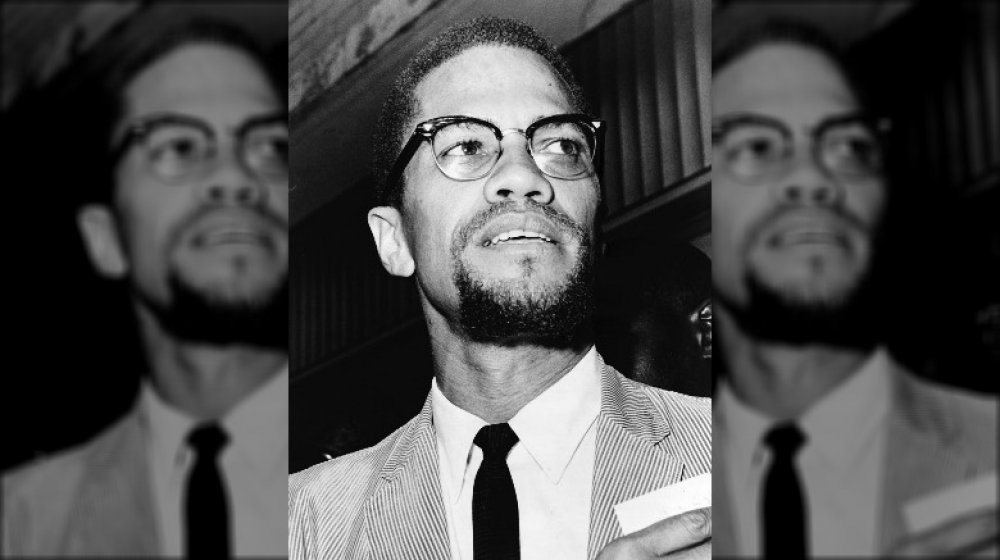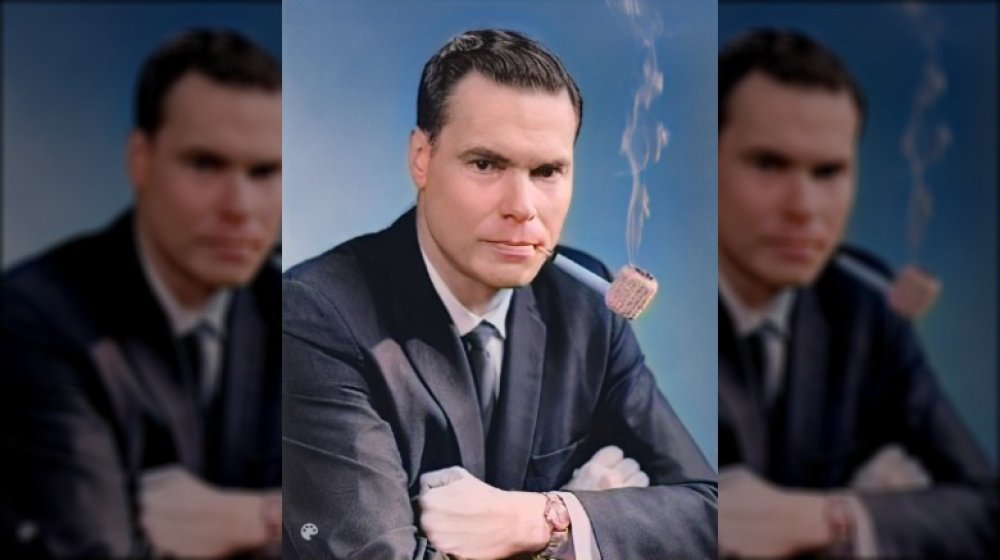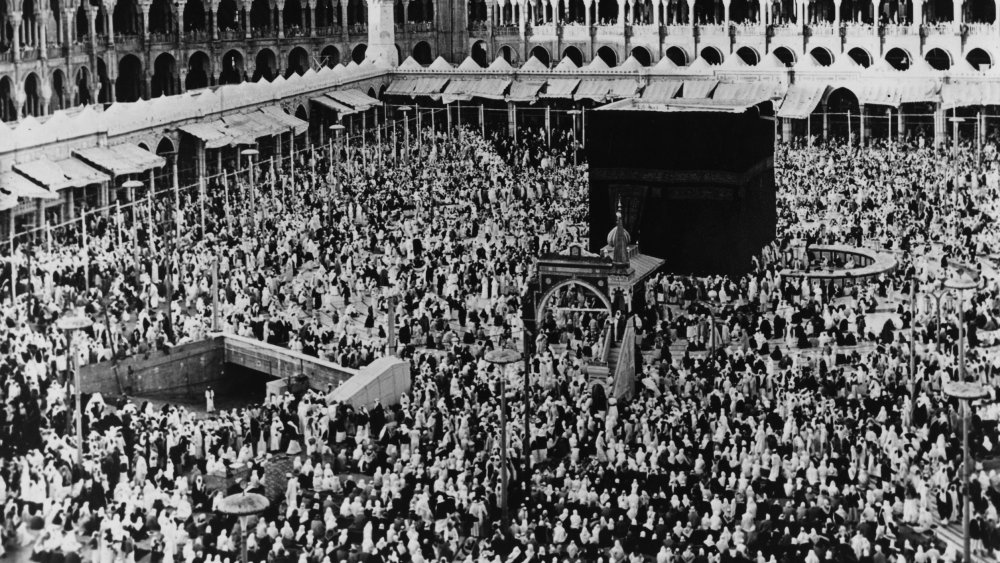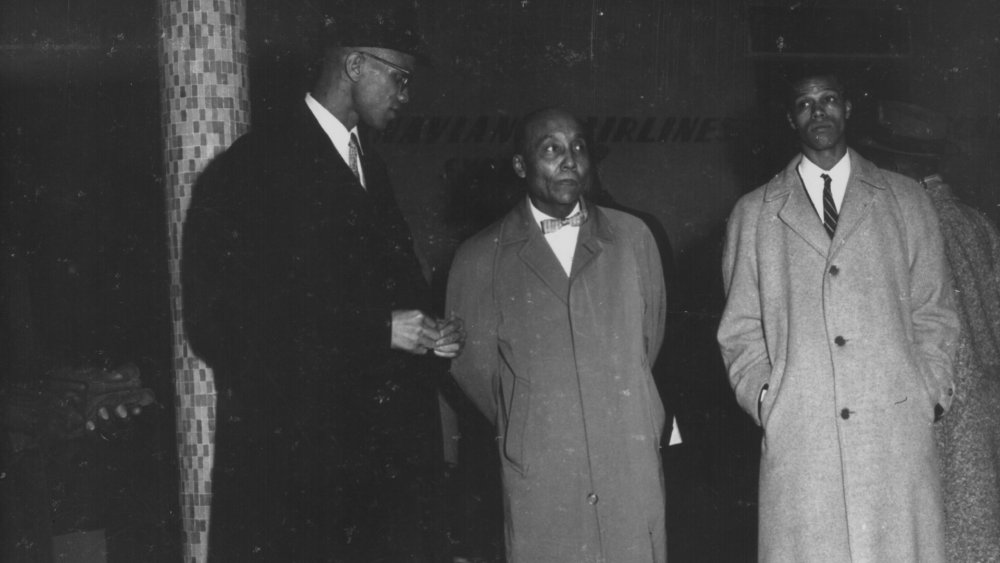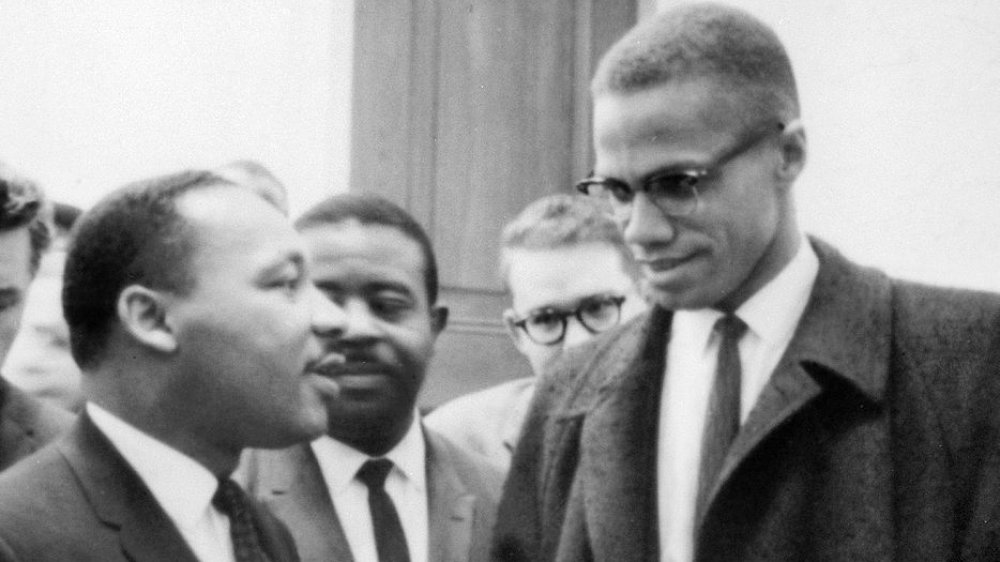False Things You Believe About Malcolm X
Malcolm X remains one of the most complex and controversial figures in American history. Sometimes overshadowed by more famous figures like Dr. Martin Luther King Jr. and often demonized for statements that have been interpreted as violent, Malcolm X is still frequently misunderstood more than five decades after his death.
What can't be denied is his importance to the history of this country, especially when it comes to race relations and the ongoing struggle of Black Americans to attain true equality. As recent events and the surge of support for the Black Lives Matter movement have proven, this work is far from over. This makes the work and words of Malcolm X even more important to anyone seeking to truly understand the true state of our society.
And yet, in part because of his complexity and his shifting views, there are many persistent myths about Malcolm X, ranging from his attitudes toward violence to his personal life and even his sexuality. Here are some of the false things you believe about Malcolm X, and why it's important for you to know the truth.
Myth: Malcolm X was a racist
One of the most persistent — and most destructive — myths about Malcolm X is that he was a racist who hated white people. The truth is much more complicated.
As the Black Muslim website Sapelo Square notes, it's true that one of the most famous quotes associated with Malcolm X is the blunt statement, "The white man is the devil." That would seem, on its face, to be a pretty racist statement, and certainly, the Nation of Islam is and has always been an explicitly racist organization preaching an innate superiority of Black people over white people, according to the Southern Poverty Law Center. And Malcolm X probably was racist when he said it. But people can change.
After he traveled to Mecca and spent several months studying and worshiping there, Malcolm X changed. As The New York Times reported, he returned from this experience with a completely new perspective — and explicitly and forcefully rejected his prior racism. He wrote, "I totally reject Elijah Muhammad's racist philosophy, which he has labeled 'Islam' only to fool and misuse gullible people, as he fooled and misused me." Malcolm X went on to write, "I have eaten from the same plate, drunk from the same glass, and slept in the same bed (or on the same rug) — while praying to the same God — with fellow Muslims, whose eyes were the bluest of blue, whose hair was the blondest of blond, and whose skin was the whitest of white," making his change of heart very clear.
Myth: Malcolm X was part of the Civil Rights movement
If you're only half-paying attention to history, it's easy to see how you might conflate Malcolm X with other famous civil rights leaders like Martin Luther King Jr. or John R. Lewis. In the 1960s, when the civil rights movement became a national story, Malcolm X was grabbing his share of headlines advocating for change.
But the truth is that while Malcolm X's life and career paralleled the civil rights movement, he wasn't actually part of it. As Sapelo Square notes, he rejected the idea of nonviolent protest as an effective tool for reformation, and his religion marked him as an outsider to the largely Christian-led civil rights movement. He was also more of a revolutionary. History reports that he had disdain for the nonviolent tactics of Martin Luther King Jr., referring to King's famous "I Have a Dream" speech as the "Farce on Washington."
Until later in life, Malcolm X believed that racial integration would never be workable. He advocated for Black nationalism and segregation, a far cry from the goals of the formal civil rights movement. In fact, he criticized the movement for its narrow domestic focus, arguing that Black people should push for "human rights" around the world instead of "civil rights" in one country.
Myth: Malcolm X advocated violent revolution
One of the most famous photographs of Malcolm X shows him peering through the blinds of his home in Queens, New York, while holding an M1 Carbine. In the caption that accompanied the photo in Ebony magazine, Malcolm X makes it clear that the pose is meant to underscore his determination to protect his family. This attitude was justified not long after, when his home was firebombed in the middle of the night — shortly before he was assassinated.
Images like this, combined with several of Malcolm's quotes (like his famous "ballot or the bullet" speech) make it seem like he wanted to use violence to achieve his ends — and possibly even foment revolution to achieve his explicitly Black nationalist goals.
In truth, as The Boston Review writes, although Malcolm X rejected the efficacy of nonviolent protest, he never advocated offensive violence. He advocated self-defense and acknowledged that it might require violence. As he said, "I am not against using violence in self-defense. I don't call it violence when it's self-defense, I call it intelligence." The distinction between violence employed in self-defense versus violence advocated as a means to achieving your goals is crucial and key to understanding Malcolm X's approach to achieving real change in America.
Myth: Malcolm X was a violent criminal
Part of Malcolm X's story is his constant evolution: losing his father as a young boy, growing up in poverty, and serving time in prison before emerging as the thoughtful, outraged face of the Nation of Islam — and then evolving again to reject that racist ideology. But his time in prison makes it easy to assume that he was a violent criminal, placing him into a stereotype of the "angry Black man" who later channeled his violence into his incendiary speeches.
As History explains, the truth is more complicated. Born Malcolm Little, his father was killed shortly after the family moved to Michigan, and his mother suffered a nervous breakdown. Malcolm was eventually sent to a juvenile detention home and enrolled in an all-white junior high school. Malcolm stole from local stores to try and help his family, but despite the trauma he'd lived through, he did very well in school and was at the top of his class. Encouraged by his success, Malcolm Little expressed an ambition to become a lawyer. One of his teachers angrily discouraged him, saying that becoming a lawyer was "no realistic goal" for a Black man (though the teacher used a different word).
Malcolm dropped out of school shortly afterward. He eventually moved to New York, where he was arrested for a series of thefts and armed robberies which landed him in prison for more than six years — but none of his crimes were especially violent.
Myth: Malcolm X was killed by white racists
While many like to remember the 1960s as a decade of peace and love, it was a turbulent, violent time in American history, marked by several assassinations of civil rights leaders by angry white people. So it's an obvious assumption that Malcolm X was killed by white racists, but the truth is more complicated: He was assassinated by members of the Nation of Islam.
As Time reports, three members of the Nation of Islam were convicted of Malcolm X's murder: Talmadge Hayer (or Thomas Hagan, also known as Mujahid Abdul Halim), Norman Butler (aka Muhammad Abdul Aziz) and Thomas Johnson (aka Khalil Islam). The key thing to remember is the anger that exploded in the Nation of Islam when Malcolm X made his very public break with the organization and its leader, Elijah Muhammad. Malcolm X didn't simply leave the group — he denounced everything he had recently stood for and explicitly called Muhammad a racist. This did not go over well with the other members, and he began receiving death threats almost immediately.
Hayer was detained at the scene by members of the audience and admitted his guilt. Butler and Johnson have always maintained their innocence — which Hayer confirmed, claiming that four completely different men were his co-conspirators. This leaves open the possibility that there's more to Malcolm X's assassination than punishment for betraying the Nation of Islam, but there's little doubt that the men who shot Malcolm X to death were Black men.
Myth: Malcolm X's assassination was a surprise
Assassination depends on an element of surprise. That's why they're so shocking and devastating — they're acts of terrorism. You might assume that assassinating a public figure like Malcolm X, a crime committed in a public space, in full view of an audience, could only have succeeded if its planning was secret. There's no way it could have been pulled off if, say, the Federal Bureau of Investigation knew it was coming.
Except, as The Baltimore Sun reports, the FBI has acknowledged that they had been surveilling both Malcolm X and the Nation of Islam for years. The FBI's largely illegal COINTELPRO program sought to infiltrate what it saw as subversive organizations in order to subvert them from within, and as The Atlantic notes, FBI director J. Edgar Hoover specifically ordered agents to target Black activists and organizations. Many suspect that the FBI had a highly placed informant in the Nation of Islam and used that informant to drive a wedge between Malcolm X and the Nation's leader, Elijah Muhammad.
This is significant, because it's difficult to believe that the FBI didn't have advance warning of the assassination. That'd mean they did nothing to stop it, which makes a federal law enforcement agency complicit in a premeditated murder.
Myth: Malcolm X was first exposed to Black Nationalist politics in prison
The summary of Malcolm X's life is easy enough: He was born into a poor, broken family, became a criminal, and went to prison, where he was exposed to Islam. Transformed, he changed his name to symbolize his awakening and emerged the angry but focused Black nationalist remembered by history. That's accurate enough, but it implies that Malcolm X went into prison completely ignorant of radical Black nationalist politics, which isn't true. He had a solid background in Black nationalism through his parents, Earl and Louise Little — who paid a similarly violent price for their activism.
As PBS reports, Malcolm X's parents were both active members of the Universal Negro Improvement Association (UNIA), a group founded by Marcus Garvey (pictured above) to promote Black racial pride and economic prosperity, with the ultimate goal of forming an independent nation in Africa for Black Americans. Earl would sometimes take young Malcolm to UNIA meetings with him, exposing him to the fundamental concepts of Black Nationalism.
Another lesson the young Malcolm X learned was the violence that white people would wield to discourage such activities. The Littles suffered violent harassment at the hands of the Ku Klux Klan, and Malcolm X believed that his father had been assassinated by the KKK.
Myth: Malcolm X was straight
Malcolm X remains controversial in the modern day in large part due to the violence perceived in some of his most famous statements. His unyielding attitude toward white supremacy has made him an enduring icon of resistance but has also opened his legacy up to accusations of racism and intolerance. But there's another aspect of his life that has been surprisingly controversial: his sexuality.
This might be surprising, since Malcolm X had a wife and family and preached a conservative brand of sex as a leading member of the Nation of Islam. But as The Guardian writes, author Bruce Perry detailed several homosexual experiences in Malcolm X's youth, as well as the young Malcolm Little's career as a male prostitute in his early twenties, prior to his incarceration. While many of these encounters were obviously motivated by money — Berry writes of Malcolm "bragging" about the money he earned servicing gay men — there is also evidence that he engaged in homosexual relationships outside of purely business purposes.
In short, it's likely that Malcolm X was bisexual or homosexual. Whatever the truth, it's complicated — though why it's controversial is a deeper dive into the lingering bias against certain lifestyles that persists no matter how much time goes by.
Myth: Malcolm X would never ally with white supremacists
Malcolm X once referred to white people as "the Devil" and was an outspoken proponent of Black nationalism "by any means necessary." Prior to his conversion to traditional Islam in 1964, his rhetoric was laced with violent imagery and unbending resistance to white supremacy. Undoubtedly, such a man would never tolerate literal white supremacists, much less negotiate with them.
And yet, as Vice reports, Malcolm X certainly did. In 1961, Malcolm X, in his role as national representative of the Nation of Islam, met with representatives of both the Ku Klux Klan and the American Nazi Party (ANP). The leader of the ANP, George Lincoln Rockwell, even attended a Nation of Islam rally in Washington, DC, politely listening to a speech given by Malcolm X and donating money.
The meeting with the KKK was pragmatic: The Nation of Islam wanted guaranties of safety for a local mosque, and they offered political support in return. But the meeting with the ANP was less easily understood. The two groups were edging toward a partnership based on their shared desire for official segregation of the races. Both Malcolm X and the American Nazis wanted white people and Black people to go their separate ways. The fact that Rockwell and his Nazis didn't believe Black people were human beings was something Malcolm X seemed willing to overlook.
Myth: Malcolm X's name was Malcolm X
Malcolm Little chose the name "Malcolm X" when he converted to Islam in prison, a tradition of the Nation of Islam. He chose the surname "X" to symbolize the African-derived name he could never know. He regarded "Little" as a name conferred on his family by slave owners, and his explicit rejection of it was a powerful statement. Not only is "Malcolm X" an iconic and attention-grabbing name, but it's also a powerful statement on the destruction wrought by the institution of slavery and a reminder that this damage is ongoing, woven into the fabric of American life.
It's so powerful, in fact, that we continue to refer to the man as Malcolm X even though, as Smithsonian Magazine explains, he changed his name a second time in 1964, to El-Hajj Malik El-Shabazz. As The Baltimore Sun notes, his widow, Betty, and his children all go by the name Shabazz.
Shabazz changed his name after his transformative visit to Mecca, where he realized that his attitudes toward white people and racism had been wrong. Returning from that trip, Malcolm X resigned from the Nation of Islam, explicitly rejected the teachings of its leader, Elijah Muhammad, and took a new name to symbolize his conversion to traditional Islam. As with his first name change, this was a deliberately symbolic action to make a point — a point that gets missed as we insist on calling him by his previous name.
Myth: Malcolm X was the leader of the Nation of Islam
Malcolm X is one of the most famous and recognizable men in modern American history. Whatever your opinion of the man and his politics, you know who he is. You also likely know that he was the leader of the Nation of Islam, an organization that promoted Black nationalism and separatism.
Except, he wasn't the leader. Wallace Fard Muhammad founded the Nation of Islam in 1930, and its leader in the 1950s and 1960s was Elijah Muhammad, who headed the organization from 1934 until his death in 1975. Malcolm X began a correspondence with Muhammad from prison, and after his release, he officially joined the Nation of Islam. Elijah Muhammad quickly saw the potential in Malcolm X. As PBS reports, he appointed Malcolm to be the national representative, saying, "I want you to be well known" because "it will make me well known."
As national representative, Malcolm X quickly became the face of the Nation of Islam — but he wasn't even the official heir to Muhammad's position or even officially second-in-command. In fact, he was a controversial figure, as some members thought he was a little too enthusiastic about being the famous face of the movement. Many speculate that part of the rift between Elijah Muhammad and Malcolm X that led to the latter's public break from the Nation was Muhammad's growing jealousy of the attention Malcolm X received.
Myth: Malcolm X worked closely with Martin Luther King
So many decades later, it might seem like the civil rights movement of the 1960s was a monolithic organization or that Malcolm X and Martin Luther King, two of the most famous Black men from the period, were close allies who worked together in the cause. But that's not true at all. Not only did the two men have extremely different goals and methods, but they actually only met face-to-face once.
As The Washington Post reports, the two met on March 26, 1964, in Washington, DC, while attending a Senate hearing. They chatted briefly and parted ways. They never collaborated or worked together — or agreed. Malcolm X was often critical of King's approach to the fight for equality – History reports that he described King's famous "I Have a Dream" speech as the "Farce on Washington." He considered King's nonviolent approach to be ineffective and criticized the focus on Black people in America and the attempt to make change within the system. He even referred to King as an "Uncle Tom."
For his part, King said of Malcolm X, "I totally disagree with many of his political and philosophical views." The tragedy is that at their meeting, Malcolm X reportedly told King he was preparing to become more involved with the civil rights movement, leaving us to wonder what might have happened if these two men had not both been assassinated.
